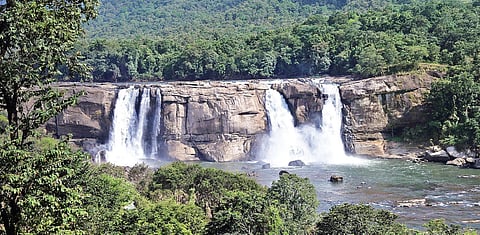

KOCHI: Two days of torrential rain had filled all upstream dams on Chalakudy river on August 15, 2018. As the flood gates of five dams were opened, water came gushing to Poringalkuthu dam which started overflowing at 4.30am on August 16. Water level in the Chalakudy river rose by 16 feet and even two-storey houses in Chalakudy town got inundated by 7am.The state government’s decision to revive the Athirappilly hydel power project has added to the fear of people living in Chalakudy basin.
“We are living under the shadow of a water bomb. What we need is flood mitigation measures, not dams, said Chalakudy River Protection Forum leader S P Ravi.There are five dams located on Chalakudy river--Parambikulam, Thoonakadavu, Upper Sholayar, Kerala Sholayar and Poringalkuthu. The first three are located in Tamil Nadu. Besides, water released from Neerar in Tamil Nadu also flows into Parambikulam. The Parambikulam dam, has a storage capacity of 505 MCM, while the maximum storage of Thoonakkadavu is 15 MCM. The Upper Sholayar dam has a storage capacity of 153 MCM.
Kerala Sholayar also has a similar storage capacity. If the flood gates of these four dams are opened, the Poringalkuthu dam, which has a storage capacity of 32 MCM, will start overflowing within two hours.
The discharge capacity of Parambikulam is 1,639 cubic metre per second, while that of Sholayar dam is 1,739 cubic metre. Thoonakadavu has a discharge capacity of 456 cubic metre. If these three dams are opened, the quantity of water reaching Poringalkuthu will be 3,882 cubic metre per second. The discharge capacity of Poringalkuthu is only 2,265 cubic metre.
“The KSEB will have to obtain clearance from the Environment Ministry. Vazhachal plays a significant role in protecting the biodiversity of the forest. There is an elephant corridor extending from Parambikulam to Pooyamkutty that passes through Vazhachal. The Kadar tribe in Vazhachal forest holds community forest rights over 4,000 hectares of forest land in the area. The project cannot be implemented without their consent,” he said.
Though undergoing treatment for liver disease, the fire in the mind of Geetha, the tribal head of Kadars in Vazhachal, refuses to submit. “The case is pending before the court. This is the first tribal settlement in the country where tribals have been provided rights over forest land. The government will have to consider the decision of the Ooru koottam,” she said. The low-elevation riparian forest of Vazhachal is the only location where all the four South Indian species of hornbills are found.
“To ensure the constant flow of water to Athirappilly waterfalls, we had proposed to generate only 3 MW during day time and drain the water into the river after generation. From 7pm to 11pm, water will be diverted to Kannankuzhy powerhouse for the generation of 160 MW power. Only 104.4 hectares of forest land will be submerged, of which 36.8 hectares of land is plantation,” said KSEB executive engineer (Generation) N T Job.
Govt gives NOC for Athirappilly hydel project
T’Puram: Kicking up a major political row, the state government has given NOC for the controversial Athirappilly hydroelectric project of the Kerala State Electricity Board. The Power Department’s order issued on June 4 said the NOC is for a period of seven years and the KSEB has been permitted to proceed with the project implementation. The four-decade-old proposal to build a dam over the Chalakudy river was revived by the LDF government in 2017. A year later, owing to the stiff opposition from nvironmentalists and political parties including LDF ally CPI, Power Minister M M Mani said in the Assembly that the government was backing out from the project. Besides submerging a vast expanse of ecologically fragile area, the project would require displacement of 234 tribal families.
Athirappilly project
The plan is to utilise the water released from Poringalkuthu powerhouse to generate 163 MW power. There will be a dam-top powerhouse which will have two generators with a capacity of 1.5 MW each. The project got stage 1 clearance in 1997 and stage 2 clearance in 1999. The environment clearance was extended in 2005 and 2007 respectively. The tender was invited in 1998 and work awarded in 2001. As the tribals and activists approached the court citing environmental destruction, destruction of habitat and tribal rehabilitation, the project was stopped.
KSEB proposal to control flooding of Chalakudy basin
The KSEB had proposed to construct a dam with a capacity of 200 MCM at Poringalkuthu to contain floodwaters released from upstream dams. Another proposal was to deepen the 7-km long canal from Vachumaram to Idamalayar dam so that floodwaters could be diverted to Idamalayar, which has a storage capacity of 1,000 MCM.
Dam site: Vazhachal
Height: 23 m
Length: 311 m
Storage: 8.44 MCM
Dam-top powerhouse:
1.5 MW x 2
Powerhouse: Kannankuzhy
Generators:
80 MW x 2
Expected annual generation:
329.94 MU